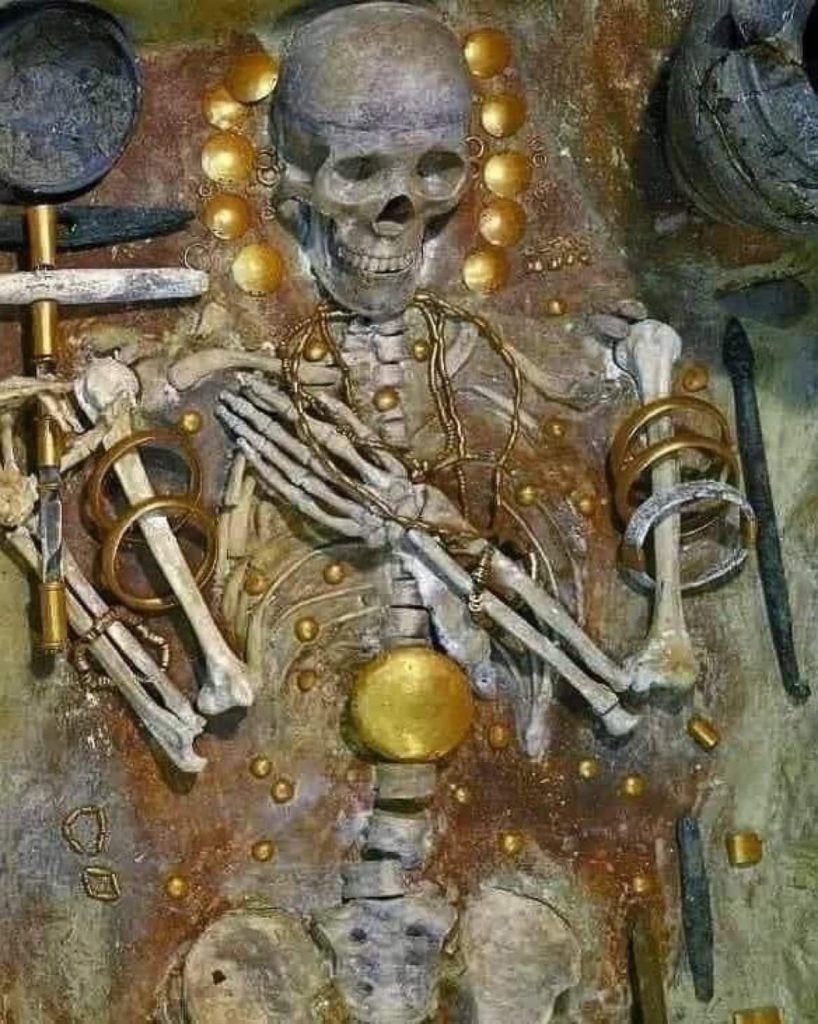In the 1970s, archaeologists in Bulgaria made an extraordinary discovery near the modern city of Varna. This discovery was the Varna Necropolis, a massive Copper Age burial site dating back to the 5th millennium BC. Among its treasures were the earliest golden artifacts ever found, a revelation that stunned the archaeological community. However, the true magnitude of this discovery became apparent when researchers unearthed grave 43, which held evidence of a remarkable culture and advanced society.
Grave 43, often referred to as the richest grave of its time, contained more gold than had ever been found in a single location in the world. Inside the grave, archaeologists discovered the remains of a high-status male, accompanied by a wealth of treasures. Among the items was a scepter, a symbol of authority and power, and a solid gold sheath designed to cover his genitalia, highlighting his elite status. This individual, now famously known as the Varna Man, represents the earliest known example of an elite male burial in Europe. The opulence of grave 43 provided unparalleled insight into the social hierarchy and cultural sophistication of the Varna civilization.

The Varna culture, as this ancient society came to be known, flourished approximately 7,000 years ago along the shores of the Black Sea. This civilization emerged during the Copper Age and became notable for its remarkable advancements in metallurgy and craftsmanship. Significantly, the Varna culture was the first known society to create golden objects, predating even the great civilizations of Mesopotamia and Egypt. This achievement underscores the Varna people’s ingenuity and their place as pioneers in human cultural and technological development.
Goldsmithing appeared in the Varna region between 4600 and 4200 BC, marking a turning point in the development of metallurgy. During this period, craftsmen mastered the techniques of smelting copper and gold, creating exquisite artifacts that became highly sought after in trade. The society’s metallurgical advancements not only elevated their craftsmanship but also established Varna as a vital trade hub. Economic interactions with neighboring regions, including the northern and southern Black Sea territories and the Mediterranean basin, enriched the Varna culture and expanded its influence. This network of trade facilitated cultural and technological exchanges that contributed to the broader development of ancient European societies.
The Varna Necropolis offers invaluable insights into the complex social structure and funerary practices of this advanced civilization. The burial site’s arrangement reflects a highly stratified society, with distinctions made based on social and economic status. Elite members of Varna society were interred in lavish graves adorned with gold ornaments, elaborate jewelry, and other precious grave goods. In contrast, individuals of lower status received simpler burials, emphasizing the pronounced social hierarchy that characterized this culture.
One of the most intriguing aspects of the Varna necropolis is its funerary rituals, which reveal a deep spiritual and symbolic dimension. Researchers observed distinct patterns in how male and female bodies were positioned within graves. In some instances, graves contained no skeletal remains but were instead filled with symbolic grave goods. These “symbolic graves,” or cenotaphs, often held some of the richest and most elaborate artifacts, suggesting a belief system that extended beyond physical remains. Additionally, the presence of clay masks and female-shaped amulets points to complex and possibly ritualistic burial practices that held significant cultural and spiritual meaning.
As the Varna culture thrived, it demonstrated exceptional creativity and resourcefulness, setting the stage for the development of future European civilizations. However, toward the end of the 5th millennium BC, the culture began to decline. Despite its eventual disappearance, the legacy of the Varna culture endures in its profound contributions to European history and development. The society’s advancements in metallurgy, coupled with its complex social structure, laid the foundation for centralized authority and social stratification in later civilizations.
The Varna culture’s influence on the evolution of European societies cannot be overstated. By establishing the earliest known example of centralized authority and hierarchical society, the Varna people provided a blueprint for subsequent civilizations to follow. Their sophisticated craftsmanship, mastery of metallurgy, and ability to engage in long-distance trade exemplified the qualities necessary for a thriving and enduring society. These advancements not only enriched their own culture but also catalyzed the progress of neighboring regions, leaving an indelible mark on the trajectory of European history.
Even today, the discoveries at the Varna Necropolis continue to captivate scholars and enthusiasts alike. The unparalleled craftsmanship and wealth of the Varna Man’s grave remain a testament to the society’s ingenuity and cultural significance. Moreover, the insights gained from studying the Varna culture have broadened our understanding of early European civilizations, shedding light on the interconnectedness and shared heritage of ancient societies.
The remarkable findings at the Varna Necropolis underscore the importance of archaeology in uncovering humanity’s past and understanding the roots of modern civilization. The Varna culture, with its groundbreaking achievements and sophisticated society, serves as a reminder of humanity’s capacity for innovation and resilience. By studying this ancient civilization, we gain not only knowledge of our shared history but also inspiration from the creativity and ingenuity of those who came before us. The Varna Necropolis, and particularly grave 43, remains one of the most significant archaeological discoveries of the 20th century, offering a glimpse into a world that continues to shape our present and future.





